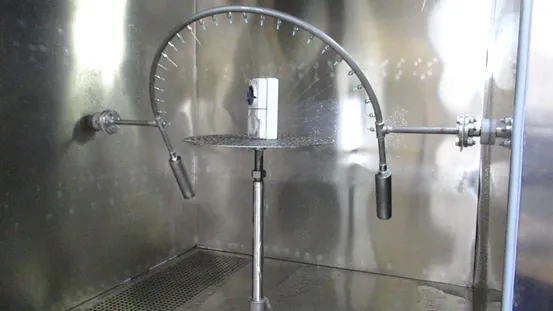EN 61386 Conduit Systems IP Resistance Testing
The EN 61386 standard is a critical part of ensuring that electrical and electronic equipment meet the necessary safety, reliability, and durability standards. Within this framework, conduit systems play an essential role in protecting wiring and harnesses from environmental factors such as water, dust, and other contaminants. The IP (Ingress Protection) rating provided by EN 61386 helps to define how effectively these conduits can prevent the ingress of foreign objects into the electrical enclosure.
Compliance with this standard is particularly important for industries like automotive, aerospace, medical devices, and industrial electronics where reliability and safety are paramount. The test procedures outlined in EN 61386 ensure that conduit systems meet the necessary IP ratings, thereby safeguarding the integrity of electronic components within the equipment.
The testing process involves subjecting the conduit system to various environmental conditions designed to mimic real-world scenarios. This includes exposure to water spray, dust ingress, and temperature variations. The goal is to evaluate how well the conduit can withstand these elements without compromising performance or reliability.
For quality managers and compliance officers, it's essential to understand not only the theoretical aspects of IP ratings but also the practical implications for product design and manufacturing processes. By adhering to EN 61386 standards during development stages, manufacturers can ensure that their products will perform reliably under expected environmental conditions.
Compliance with these tests is crucial for ensuring long-term durability and safety of electronic equipment across various sectors. Meeting the specified IP ratings not only enhances product reliability but also contributes to overall customer satisfaction by reducing maintenance costs and potential failures due to premature damage from environmental factors.
- Water Resistance: Testing ensures that water cannot penetrate the conduit, preventing short circuits or other malfunctions caused by moisture ingress.
- Dust Protection: Ensures that dust particles do not accumulate inside the electrical enclosure, which could lead to poor heat dissipation and increased risk of component failure.
Benefits
The benefits of EN 61386 conduit systems IP resistance testing extend beyond mere compliance with regulatory requirements; they contribute significantly to the overall quality, safety, and longevity of electronic devices. Here are some key advantages:
- Enhanced Reliability: By ensuring that conduits meet rigorous IP rating standards, manufacturers can reduce the likelihood of failures due to environmental factors.
- Improved Customer Satisfaction: Products that pass these tests tend to have higher reliability rates, leading to increased customer trust and satisfaction.
- Cost Savings: Early detection of potential issues through comprehensive testing can save significant costs associated with product recalls or warranty claims after release into market.
In addition, meeting these standards can help companies gain a competitive edge by demonstrating their commitment to high-quality manufacturing practices. This is especially valuable in highly regulated industries such as healthcare and aviation where trustworthiness plays a crucial role.
Quality and Reliability Assurance
- Consistent Quality: Ensures that every batch of conduit systems produced meets the same high standards, reducing variability in performance across different batches.
- Risk Management: Identifies potential risks early on so they can be addressed before they become major problems during production or use.
The rigorous testing procedures required by EN 61386 help maintain consistent quality levels throughout the manufacturing process. This consistency is critical for maintaining reliable performance over extended periods, which ultimately leads to longer product lifecycles and reduced downtime.
By implementing robust quality assurance measures based on EN 61386 standards, manufacturers can minimize risks associated with environmental factors that could compromise the integrity of their products. This proactive approach contributes significantly to improved reliability and customer satisfaction.
Use Cases and Application Examples
The use cases for EN 61386 conduit systems IP resistance testing are broad and varied, spanning multiple industries where environmental conditions pose significant challenges. Some key examples include:
- Aerospace Industry: Ensuring that electronic components remain protected from harsh weather conditions during flight.
- Automotive Sector: Guaranteeing that wiring harnesses inside vehicles are shielded against road dust and other environmental contaminants.
- Medical Devices: Providing a secure environment for sensitive medical electronics in hospitals and clinics where contamination can pose serious health risks.
In these sectors, compliance with EN 61386 ensures that the conduit systems used are capable of withstanding extreme conditions without compromising performance or reliability. This is especially important given the critical nature of many applications within these industries.
For R&D engineers involved in developing new products or improving existing ones, understanding the requirements set forth by EN 61386 can provide valuable insights into best practices for designing robust conduit systems. By leveraging this knowledge early in the design phase, they can ensure that their innovations are not only innovative but also reliable and safe.





